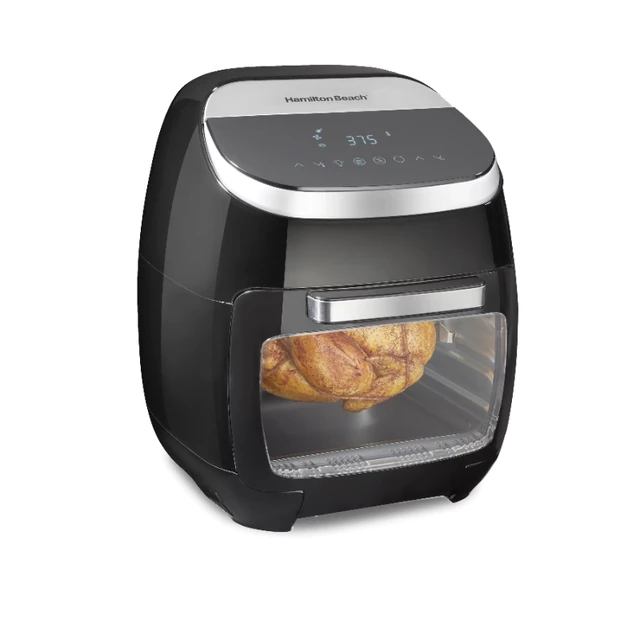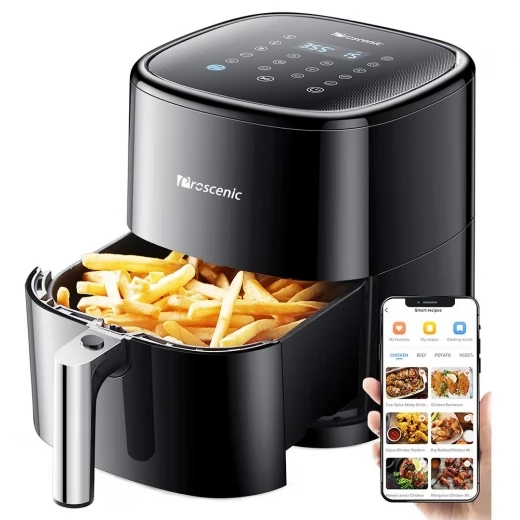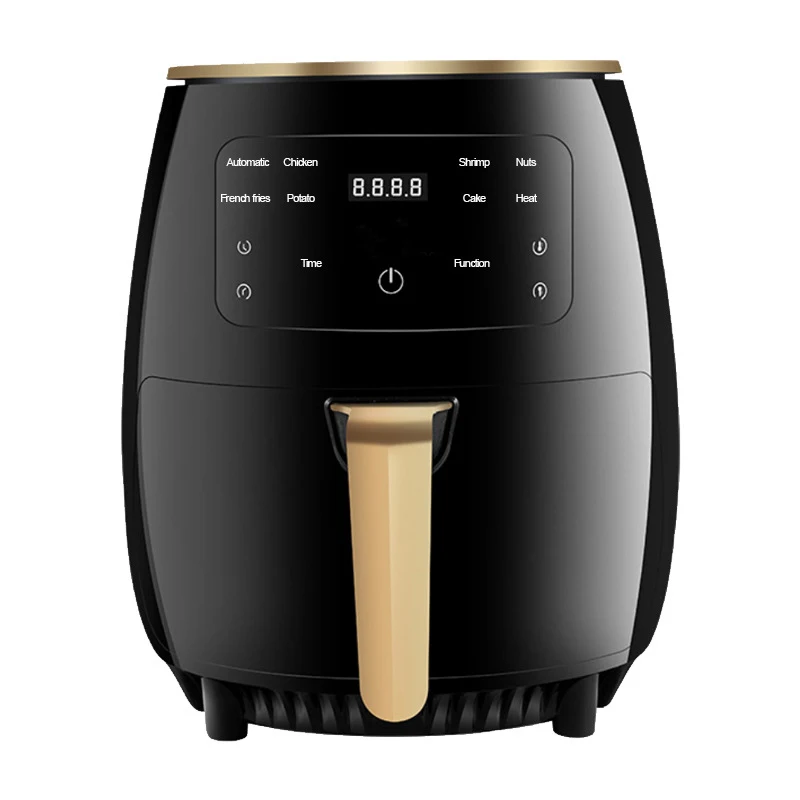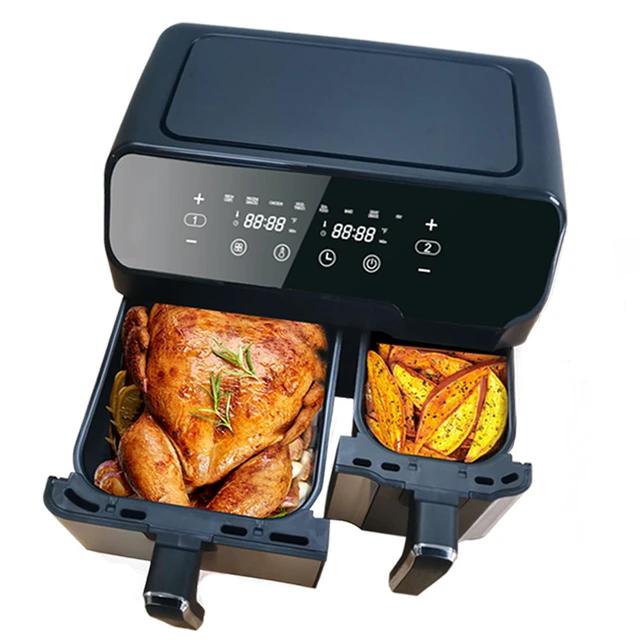Introduction:
Air frying has gained popularity as a healthier alternative to traditional deep frying methods. With the increasing demand for air frying, manufacturers have introduced different appliances, such as air fryers and air fryer ovens, to cater to varying cooking needs. While both appliances offer the benefits of air frying, there are key differences between them. In this article, we will explore the distinctions between an air fryer and an air fryer oven, including their design, cooking capacity, versatility, and additional features. By understanding these differences, you can make an informed decision on which appliance best suits your cooking requirements.

What is the difference between an air fryer and an air fryer oven?
Design and Size:
a. Air Fryer: Air fryers are compact countertop appliances designed specifically for air frying. They typically have a basket or drawer-shaped cooking compartment where the food is placed. Air fryers come in various sizes, ranging from small models suitable for individuals or couples to larger ones that can accommodate family-sized portions. Their compact design makes them ideal for kitchens with limited counter space.
b. Air Fryer Oven: Air fryer ovens are larger appliances that resemble traditional toaster ovens or convection ovens. They offer the functionality of an air fryer along with additional cooking options. Air fryer ovens have spacious interiors with multiple racks or shelves, allowing for larger cooking capacities and the ability to cook multiple dishes simultaneously. Their larger size and additional features make them suitable for larger families or those who regularly cook for more people.
Cooking Capacity:
a. Air Fryer: Air fryers have a limited cooking capacity due to their compact size. The capacity is typically measured in quarts and can range from 1 to 6 quarts, depending on the model. This makes them suitable for cooking small to moderate-sized portions of food. Air fryers are ideal for individuals or small families who primarily want to air fry snacks, appetizers, or single servings of food.
b. Air Fryer Oven: Air fryer ovens offer larger cooking capacities compared to air fryers. They can accommodate larger quantities of food and have multiple racks or shelves, allowing you to cook multiple dishes simultaneously. Air fryer ovens are suitable for cooking family-sized meals, roasting whole chickens, or preparing larger batches of food for gatherings or parties.

Cooking Versatility:
a. Air Fryer: Despite their limited cooking capacity, air fryers excel at air frying. They use rapid air circulation to cook food with little to no oil, resulting in crispy and evenly cooked dishes. Air fryers can also be used for baking, grilling, and roasting, although their size may limit the types of dishes that can be prepared. Some air fryers come with additional cooking functions, such as dehydrating or reheating, to provide more versatility.
b. Air Fryer Oven: Air fryer ovens offer a higher level of cooking versatility compared to air fryers. In addition to air frying, they often include features like baking, broiling, toasting, and even convection cooking. Air fryer ovens can be used to prepare a wide variety of dishes, including pizzas, casseroles, cookies, and more. They provide a convenient all-in-one cooking solution, eliminating the need for multiple appliances in the kitchen.
Additional Features:
a. Air Fryer: Air fryers typically have simple and user-friendly controls, with options for adjusting time and temperature settings. Some models may offer preset cooking programs for popular food items, making it easier to achieve consistent results. Air fryers often have removable and dishwasher-safe components, such as the fryer basket, making cleaning relatively easy. They are designed to be compact and portable, allowing for easy storage and transportation.
b. Air Fryer Oven: Air fryer ovens come with additional features compared to air fryers. They usually have more advanced control panels with digital displays, temperature probes, and a wider range of cooking presets. Air fryer ovens often include additional cooking accessories, such as baking pans, broiling racks, or rotisserie spits, to enhance cooking versatility. Cleaning air fryer ovens may require more effort as they have larger cooking compartments and more components, which may not be dishwasher-safe.

Price:
a. Air Fryer: Air fryers are generally more affordable compared to air fryer ovens. Their compact size and simpler design contribute to their lower price range. Air fryers are a cost-effective option for those primarily interested in air frying and have limited cooking needs.
b. Air Fryer Oven: Air fryer ovens are typically more expensive than air fryers due to their larger size, additional features, and increased cooking capacity. The price range can vary depending on the brand, size, and specific features of the appliance. Air fryer ovens are a suitable investment for those who require a multi-purpose cooking appliance with larger cooking capacities.
Cooking Performance:
a. Air Fryer: Air fryers are specifically designed for air frying, and they excel at delivering crispy and evenly cooked results. The rapid air circulation technology ensures that the food is evenly coated and cooked, providing a healthier alternative to deep frying. Air fryers are known for their ability to produce crispy fries, chicken wings, and other fried snacks without the need for excessive oil.
b. Air Fryer Oven: Air fryer ovens offer similar cooking performance to air fryers when it comes to air frying. They use the same rapid air circulation technology to achieve crispy and evenly cooked results. However, due to their larger size and multiple racks/shelves, air fryer ovens provide more even heat distribution and can handle larger quantities of food. This makes them suitable for cooking a wider variety of dishes, including larger cuts of meat, whole chickens, and even baked goods.

Energy Efficiency:
a. Air Fryer: Air fryers are generally more energy-efficient than traditional ovens. They require less time and energy to preheat and cook food, saving both time and electricity. Air fryers also tend to have shorter cooking times due to the rapid air circulation technology, further reducing energy consumption.
b. Air Fryer Oven: Air fryer ovens are larger appliances and may consume more energy compared to air fryers. However, they are still more energy-efficient than traditional ovens. Air fryer ovens use convection technology to circulate hot air, which speeds up the cooking process and reduces overall cooking time. This helps to minimize energy usage compared to using a full-sized oven for the same cooking tasks.

Conclusion:
While both air fryers and air fryer ovens offer the benefits of air frying, they differ in terms of design, cooking capacity, versatility, additional features, and price. Air fryers are compact countertop appliances with limited cooking capacities, ideal for individuals or small families who primarily want to air fry. On the other hand, air fryer ovens are larger appliances that resemble traditional ovens and offer a higher level of cooking versatility. They have larger cooking capacities and can accommodate multiple dishes simultaneously, making them suitable for larger families or those who require more cooking options. The choice between an air fryer and an air fryer oven ultimately depends on your cooking needs, available space, and budget.

